混凝土或其他脆性材料的塑性破坏
混凝土结构设计原理复习试题
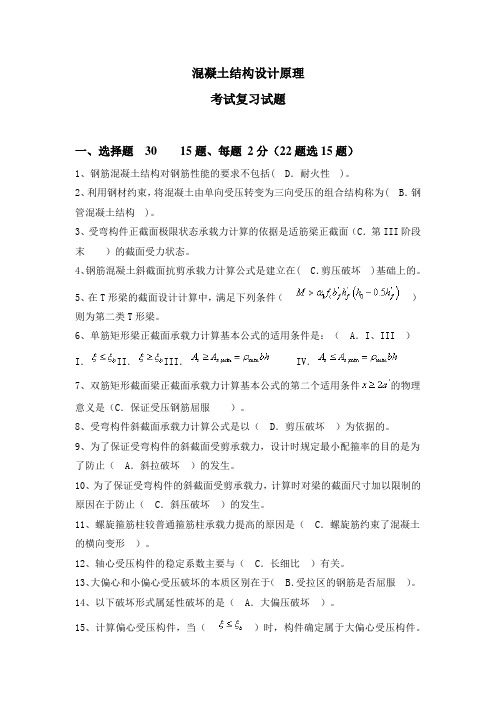
混凝土结构设计原理考试复习试题一、选择题30 15题、每题2分(22题选15题)1、钢筋混凝土结构对钢筋性能的要求不包括( D.耐火性 )。
2、利用钢材约束,将混凝土由单向受压转变为三向受压的组合结构称为( B.钢管混凝土结构 )。
3、受弯构件正截面极限状态承载力计算的依据是适筋梁正截面(C.第III阶段末)的截面受力状态。
4、钢筋混凝土斜截面抗剪承载力计算公式是建立在( C.剪压破坏 )基础上的。
5、在T形梁的截面设计计算中,满足下列条件()则为第二类T形梁。
6、单筋矩形梁正截面承载力计算基本公式的适用条件是:(A.I、III )I.II.III. IV.7、双筋矩形截面梁正截面承载力计算基本公式的第二个适用条件的物理意义是(C.保证受压钢筋屈服)。
8、受弯构件斜截面承载力计算公式是以(D.剪压破坏)为依据的。
9、为了保证受弯构件的斜截面受剪承载力,设计时规定最小配箍率的目的是为了防止(A.斜拉破坏)的发生。
10、为了保证受弯构件的斜截面受剪承载力,计算时对梁的截面尺寸加以限制的原因在于防止(C.斜压破坏)的发生。
11、螺旋箍筋柱较普通箍筋柱承载力提高的原因是(C.螺旋筋约束了混凝土的横向变形)。
12、轴心受压构件的稳定系数主要与(C.长细比)有关。
13、大偏心和小偏心受压破坏的本质区别在于(B.受拉区的钢筋是否屈服)。
14、以下破坏形式属延性破坏的是(A.大偏压破坏)。
15、计算偏心受压构件,当()时,构件确定属于大偏心受压构件。
16、其它条件相同时,钢筋的保护层厚度与平均裂缝间距、裂缝宽度的关系是( A .保护层越厚,平均裂缝间距越大,裂缝宽度越大 )。
17、条件相同的钢筋混凝土轴拉构件和预应力混凝土轴拉构件相比较,( B .后者的抗裂度比前者好 )。
18在预应力混凝土构件的预应力损失计算中,( D .混凝土收缩徐变引起的预应力损失 )是所有预应力损失中最大的一项。
19下列各项预应力损失类型中,不属于后张法预应力损失的是( C .温差损失 )20矩形截面不对称配筋小偏拉构件在破坏时( B .没有受压区,受拉不屈服 )。
混凝土结构设计原理试题及答案

混凝⼟结构设计原理试题及答案混凝⼟结构设计原理期末复习资料试卷题型:⼀、选择(30’)1.适筋梁从加载到破坏可分为三个阶段,各个阶段受⼒的特点及各阶段的作⽤:答:适筋梁的破坏过程分三个阶段:弹性阶段、带裂缝⼯作阶段、破坏阶段,也称第⼀、⼆、三阶段。
弹性阶段主要是梁下部的混凝⼟与钢筋共同承受拉⼒,未出现裂缝;带裂缝⼯作阶段是下部混凝⼟出现裂缝,退出⼯作,拉⼒全部由钢筋承受;破坏阶段是当上部混凝⼟受压破坏。
这三个阶段有两个临界点:就是第⼀阶段与第⼆阶段之间的受拉区混凝⼟出现裂缝,第⼆阶段与第三阶段的受压区混凝⼟被压裂。
2.当单筋矩形截⾯梁的截⾯尺⼨、材料强度及弯矩设计值确定后,计算时发现超筋、采取什么措施?什么措施最有效?答:当⼀单筋矩形截⾯梁的截⾯尺⼨、材料强度及弯矩设计值M确定后,计算时发现超筋,那么采取( B )措施提⾼其正截⾯承载⼒最有效。
A.增加纵向受拉钢筋的数量 B.加⼤截⾯⾼度C.加⼤截⾯宽度 D.提⾼混凝⼟强度等级3.梁的斜截⾯抗剪承载⼒计算中,其计算位置?答:斜截⾯抗剪承载⼒复核《公路钢筋混凝⼟及预应⼒混凝⼟桥涵设计规范》JTG D62-2004 规定需要验算的位置为:(1)距⽀座中⼼h/2处的截⾯。
因为越靠近⽀座,直接⽀承的压⼒影响也越⼤,混凝⼟的抗⼒也越⾼,不致破坏,⽽距⽀座中⼼h/2以外,混凝⼟抗⼒急剧降低。
(2)受拉区弯起钢筋弯起点处的截⾯以及锚于受拉区纵向主筋开始不受⼒处的截⾯,因为这⾥主筋中断,应⼒集中。
(3)箍筋数量或间距改变处的截⾯(4)腹板宽度改变处的截⾯,这⾥与箍筋数量或间距改变⼀样,都受到应⼒剧变、应⼒集中的影响,都有可能形成构件的薄弱环节,⾸先出现裂缝。
e.g.梁的斜截⾯抗剪承载⼒计算时,其计算位置正确的是()。
A. ⽀座边缘处B. 受拉区弯起筋的弯起点处C. 箍筋直径变化处D. 箍筋间距变化处4.受弯构件箍筋间距过⼩会发⽣?答:最⼩箍筋率主要是为了确保钢筋⾻架有⾜够的刚度和截⾯混凝⼟的抗剪,如果箍筋间距过⼤,箍筋间的主筋会因为局部混凝⼟受压产⽣侧向膨胀⽽变形。
土木工程材料习题及答案

A.提高强度
B.提高保温性
C.节约水泥
D.减少收缩开裂
得分:
0知识点:
土木工程材料作业题展开解析.答案D .解析抹灰砂浆中掺入纤维增强材料(如麻刀、纸筋等),主要是为了提高抹灰层的抗拉强度,防止抹灰层开裂。.6.
(4分)配制有抗渗要求的混凝土时,不宜使用()。
(4分)防止混凝土中钢筋锈蚀的主要措施是()。
A.减小水胶比,提高密实度
B.设置足够的钢筋保护层厚度
C.加阻锈剂
D. A+B
得分:
0知识点:
土木工程材料作业题展开解析.答案D .解析混凝土的碳化会破坏钢筋表面的钝化膜,引起钢筋锈蚀,为避免混凝土的碳化,最有效的措施是减小水胶比,提高其密实度,使碳化作用仅限于表面,不易向内部发展,从而保证混凝土内的碱性环境。当然,设置足够的钢筋保护层厚度也是必要的。.3.
A.提高强度
B.提高保温性
C.节约水泥
D.减少收缩开裂
得分:
0知识点:
土木工程材料作业题展开解析.答案D .解析抹灰砂浆中掺入纤维增强材料(如麻刀、纸筋等),主要是为了提高抹灰层的抗拉强度,防止抹灰层开裂。.7.
(4分)当采用特细砂配制混凝土时,以下哪项措施不可取?()
A.采用较小砂率;
B.增加水泥用量;
得分:
0知识点:
土木工程材料作业题展开解析.答案C .解析.18.
(4分)大体积混凝土施工时内外温差不宜超过()。
A. 10℃
B. 25℃
C. 35℃
D. 50℃
得分:
0知识点:
土木工程材料作业题展开解析.答案B .解析大体积混凝土体积厚大,内部水泥水化热不宜放出,水化热集聚在内引起内外温差超过25℃则容易产生温度应力而导致混凝土产生裂缝。.19.
电大建筑施工与管理专科《建筑材料A》期末上机考试题库(综合完整版)

电大建筑施工与管理专科《建筑材料A》期末上机考试题库(综合完整版)混凝土中孔隙率越高,连通孔隙越多,其抗冻性越好。
(×)火山灰水泥的特点是易吸水,但活性差,不易反应。
(×)加气混凝土砌块具有体积密度小、保温及耐火性能好、抗震性能强、易于加工、施工方便等特点。
(√)加气混凝土砌块最适合用于温度长期高于80℃的建筑部位。
(× )加气混凝土砌块最适合用于温度长期高于80℃的建筑部位。
(× )减水剂是指在保持混凝土拌合物流动性的条件下,能减少拌合水量的外加剂。
(√)简易房屋必须采用水泥砂浆砌筑。
(×)碱骨料反应生成的碱-硅酸凝胶吸水膨胀会对混凝土造成胀裂破坏,使混凝土的耐久性严重下降。
(√)建筑材料的微观结构主要有晶体、玻璃体和胶体等形式。
(√)建筑材料的正确、节约、合理地运用直接影响到建筑工程的造价和投资。
(√)建筑材料生产和选用时,仅需参照产品标准,无需参照工程建设标准(×)。
建筑材料是建筑工程的物质墓础。
(√)建筑材料是指组成建筑物或构筑物各部分实体的材材料(√)建筑材料种类繁多,随着材料科学和材料工业的不断发展,新型建筑材料不断涌现.. (√)建筑钢材材质均匀,具有较高的强度、良好的塑性和韧性,能承受冲击和振动荷载。
(√)建筑砂浆根据用途分类:可分为砌筑砂浆、抹面砂浆。
(√)建筑砂浆是由无机胶凝材料、细骨料和水,有时也掺入某些掺合料组成。
(√)建筑上常用的岩石有花岗岩、正长岩、闪长岩、石灰岩、砂岩、大理岩和石英岩等。
(√)建筑设计理论不断进步和施工技术的革新与建筑材料的发展无关。
(×)建筑石膏呈乌黑色粉末状,密度约为2.6-2.?5g/cm2,堆积密度为800-1100 kg/m3。
(×)建筑石膏的初凝和终凝时间很短,加水后6min即可舞结,终凝不超过30min。
(√)建筑石膏强度不随时间的变化而变化,因此可以长期存放。
国开电大-建筑材料(A)-第2-11章测试题目

题目随机, 请使用Ctrl+F组合键查找题目答案第2章测试题目: 孔隙率P计算公式式中ρ0为()选择一项:A.材料的表观密度B.材料的密度C.材料的堆积密度D.材料的体积密度题目: 下列关于材料实验及材料强度实验说法有误的一项是( )选择一项:A.一般情况, 试件温度越高, 所测强度值越高B.比强度是指材料的强度与其体积密度之比, 是衡量材料轻质高强性能的指标C.强度等级是材料按强度的分级D.一般情况下,大试件的强度往往小于小试件的强度题目: 材料传导热量的能力称为( )选择一项:A.热容B.导热性C.导电性D.比热题目: 材料密度试验不需要的仪器是()选择一项:A.李氏瓶B.游标卡尺C.天平D.烘箱题目: 空隙率P′计算公式式中ρ0′为()选择一项:A.材料的堆积密度B.材料的体积密度C.材料的表观密度D.材料的密度题目: 亲水材料的润湿角一般不大于( )选择一项:A.1200B.1500C.1800D.900题目: 下列关于材料耐磨性说法有误的一项是( )选择一项:A.磨损率等于试件在标准试验条件下磨损前后的质量差与试件受磨表面积之积B.磨损率越大, 材料的耐磨性越差C.耐磨性用磨损率表示D.耐磨性是指材料表面抵抗磨损的能力题目: 下列关于韧性和脆性说法有误的一项是 ( )选择一项:A.砖、石材、陶瓷、玻璃、混凝土、铸铁等都是脆性材料B.与韧性材料相比, 脆性材料对抵抗冲击荷载和承受震动作用是相当不利的C.脆性材料的力学性能特点是抗压强度远小于于抗拉强度, 破坏时的极限应变值极大D.路面、桥梁、吊车梁及有抗震要求的结构都要考虑材料的韧性题目: 材料密度试验的目的是()选择一项:A.测定材料的密度, 计算材料的密实度与孔隙率B.测定颗粒状材料的包括内部封闭孔隙体积的表观体积C.测定材料的堆积密度, 计算材料的质量及空隙率D.测定材料的体积密度,用来确定材料外观体积和孔隙率题目: 下列关于材料体积密度试验说法有误的一项是()选择一项:A.测定的体积密度应精确至10kg/m3B.试验准备时应将试样5块放入烘箱内, 在(105±5)℃的温度下烘干至恒量C.几何形状不规则的材料, 体积密度的测试采用“排液法”D.试验准备时当不规则试样溶于水或其吸水率小于0.5%,则须对试样进行蜡封处理题目: 材料表观密度试验以两次试验结果的算术平均值之差不应大于()选择一项:A.0.08g/cm3B.0.04g/cm3C.0.06g/cm3D.0.02g/cm3题目:材料化学组成的不同是造成其性能各异的主要原因, 研究材料的化学组成通常需研究()选择一项:A.材料的元素数量和种类B.材料的元素组成和矿物组成C.材料的物理性质和化学性质D.材料的颗粒大小和分子式题目: 下列关于耐燃性和耐火性说法有误的一项是( )选择一项:A.耐火性是材料在火焰和高温作用下, 保持其不破坏、性能不明显下降的能力B.耐火的材料不一定耐燃, 耐燃的一般都耐火C.钢材虽为重要的建筑结构材料, 但其耐火性却较差, 使用时须进行特殊的耐火处理D.耐燃性是指材料在火焰和高温作用下可否燃烧的性质题目:矿物组成和元素组成是造成材料性能各异主要原因, 其中材料的矿物组成主要是指()选择一项:A.元素组成相同, 但分子团组成形式各异的现象B.元素组成不同, 但分子团组成形式各异的现象C.元素组成相同, 分子团组成形式也相同的现象D.元素组成不同,分子团组成形式相同的现象题目:测定砂的堆积密度时, 称取试样和容量筒总质量m2, 应精确至()选择一项:A.0.04gB.1gC.0.02gD.0.06g题目:材料在绝对密实状态下, 单位体积的质量称为()选择一项:A.表观密度B.体积密度C.堆积密度D.密度题目:几何形状规则的材料在测体积密度时, 第一步应()选择一项:A.称出蜡封试样在空气中的质量B.称出蜡封试样在水中的质量C.用游标卡尺量出试样尺寸, 计算出试样的体积D.用广口瓶法测定试验的表观密度题目:材料实体内部和实体间常常部分被空气所占据, 一般称材料实体内部被空气所占据的空间为()选择一项:A.裂缝B.孔隙C.间隙D.缝隙题目: 材料的吸水性是指( )选择一项:A.指材料在潮湿空气中吸收水分的能力B.材料在长期饱和水的作用下, 不破坏、强度也不显著降低的性质C.材料在水中吸收水分达饱和的能力D.指材料抵抗压力水或其他液体渗透的性质题目:在冲击、震动荷载作用下, 材料可吸收较大的能量产生一定的变形而不破坏的性质称为 ( )选择一项:A.脆性B.弹性C.刚性D.韧性或冲击韧性题目: 下列关于材料耐久性能说法有误的一项是()选择一项:A.钢材的耐久性, 主要取决于其大气稳定性和温度敏感性B.混凝土的耐久性, 主要以抗渗性、抗冻性、抗腐蚀性和抗碳化性所体现C.材料的耐久性是一综合性能, 不同材料的耐久性往往有不同的具体内容D.影响材料耐久性的外部作用因素是多种多样的题目: 材料的密实度指的是()选择一项:A.在材料的体积内, 孔隙体积所占的比例B.散粒状材料在其堆积体积中, 被颗粒实体体积填充的程度C.材料的体积内, 被固体物质充满的程度D.散粒材料的堆积体积内,颗粒之间的空隙体积所占的比例题目: 下列关于材料构造说法有误的一项是()选择一项:A.致密状构造完全没有或基本没有孔隙B.胶合板、复合木地板、纸面石膏板、夹层玻璃都是纤维状构造C.材料在宏观可见层次上的组成形式称为构造D.多孔状构造材料一般为轻质材料题目: 材料表面耐较硬物体刻划或压入而产生塑性变形的能力称为 ( ) 选择一项:A.耐磨性B.强度C.刚度D.硬度题目: 材料的微观结构主要是指()选择一项:A.组成物质的微观粒子在空间的排列有确定的几何位置关系B.材料在原子、离子、分子层次上的组成形式C.组成物质的微观粒子在空间的排列呈无序浑沌状态D.材料的构造题目: 下列关于材料弹性和塑性说法有误的一项是( )选择一项:A.完全弹性的材料实际是不存的, 大部分材料是弹性、塑性分阶段或同时发生的B.弹性和塑性是材料的变形性能C.弹性模量E值愈大, 说明材料在相同外力作用下的变形愈大D.弹性和塑性主要描述的是材料变形的可恢复特性题目: 用来说明材料孔隙状况的三个指标分别是()选择一项:A.孔隙连通性、孔隙大小、孔隙面积B.孔隙率、孔隙连通性和孔隙直径C.孔隙个数、孔隙大小、孔隙率D.孔隙面积、孔隙大小、孔隙率题目:材料在外力作用下发生变形, 当外力解除后, 能完全恢复到变形前形状的性质称为材料的 ( )选择一项:A.弹性B.塑性C.韧性D.刚性题目: 材料在外力作用下抵抗破坏的能力称为 ( )选择一项:A.脆性B.强度C.刚度D.韧性题目: 下列关于测定砂、石子堆积密度试验说法有误的一项是()选择一项:A.测定石子堆积密度时, 需用四分法缩分至规定的质量, 在(105±5)℃的烘箱内烘干B.堆积密度等于松散堆积密度和紧密堆积密度之和C.测定砂堆积密度时, 需先用浅盘装砂约3L, 在温度为(105±5)℃的烘箱中烘干至恒量D.试验准备时应筛除公称粒径大于5mm的颗粒,分成大致相等的两份备用第3章测试题目: 下列关于岩石性质说法有误的一项是()选择一项:A.岩石的抗压强度很大, 抗拉强度也很小B.岩石的抗压强度取决于其母岩的抗压强度C.岩石是典型的塑性材料D.岩石的硬度大,强度也高题目: 料石(又称条石)是由()选择一项:A.人工或机械开采出的较规则的六面体石块, 略经加工凿琢而成的B.爆破直接获得的C.花岗岩等质地比较均匀的岩石开采琢制而成的D.乱毛石略经加工而成题目:由地球内部的岩浆上升到地表附近或喷出地表, 冷却凝结而成的岩石称为()选择一项:A.岩浆岩B.沉积岩C.变质岩D.石灰岩题目: 下列关于天然花岗石说法有误的一项是()选择一项:A.花岗石常呈整体均粒状结构, 称为花岗结构B.花岗石属碱性石材C.花岗石板材主要应用于大型公共建筑或装饰等级要求较高的室内外装饰工程D.花岗石构造致密、强度高、密度大、吸水率极低、质地坚硬、耐磨题目: 毛石按平整度可分为()选择一项:A.平毛石和乱毛石B.粗毛石和细毛石C.平毛石和细毛石D.粗毛石和乱毛石题目: 毛石指的是()选择一项:A.由爆破后, 经打磨后获得的石块B.由爆破直接获得的石块C.由条石打磨好的石块D.由料石加工获得的石块题目: 造岩矿物是指()选择一项:A.组成岩石的矿物B.组成岩石的化合物C.组成岩石的单质D.组成岩石的元素题目: 由两种或两种以上矿物组成的岩石称为()选择一项:A.白云岩B.双矿岩C.多矿岩D.单矿岩题目:料石按其加工后的外形规则程度, 分为()选择一项:A.毛料石、乱料石、平细料石和细料石B.毛料石、平料石、半细料石和乱料石C.毛料石、粗料石、平细料石和乱料石D.毛料石、粗料石、半细料石和细料石题目: 下列关于天然大理石说法有误的一项是()选择一项:A.绝大多数大理石板材只宜用于室外B.天然大理石易加工、开光性好, 常被制成抛光板材C.天然大理石质地较密实、抗压强度较高、吸水率低、质地较软, 属碱性中硬石材D.天然大理石板材是装饰工程的常用饰面材料第4章测试题目: 建筑石膏呈洁白粉末状, 密度约为()选择一项:A.4.6-4.7.g/㎝3B.3.6-3.7.g/㎝3C.5.6-5.7.g/㎝3D.2.6-2.7.g/㎝3题目:以水玻璃为基料, 加入二种或四种矾的水溶液, 称为()选择一项:A.二矾或四矾润滑剂B.二矾或四矾吸水剂C.二矾或四矾憎水剂D.二矾或四矾防水剂题目:在内部, 对强度增长起主导作用的是()选择一项:A.结晶硬化B.碳酸化硬化C.干燥硬化D.吸水硬化题目: 下列有关水玻璃的应用说法有误的一项是()选择一项:A.以水玻璃涂刷石材表面, 可提高其抗风化能力, 提高建筑物的耐久性B.水玻璃可用来配制防水剂C.水玻璃可用来配置混凝土D.水玻璃可用来涂刷石膏制品表面,浸渍多孔性材料题目: 建筑石膏的技术要求主要有()选择一项:A.细度、凝结时间和强度B.细度、凝结时间和色泽C.细度、色泽和强度D.色泽、凝结时间和强度题目: 石灰的主要成分是()选择一项:A.硫酸钙B.氧化钙和氧化镁D.氢氧化钙题目: 下列关于石灰技术性质说法有误的一项是()选择一项:A.耐水性差B.吸湿性强C.凝结硬化慢、强度低D.保水性较差题目: 生石灰水化的特点是体积增大()选择一项:A.2-3倍B.3-5倍C.4-5倍D.1-2.5倍题目: 下列有关水玻璃的性质说法有误的一项是()选择一项:A.以镁质耐火材料为骨料配制水玻璃混凝土,其使用温度可达1100℃B.水玻璃硬化后具有较高的粘结强度、抗拉强度和抗压强度C.水玻璃硬化形成SiO2空间网状骨架, 因此具有良好的耐热性能D.硬化后的水玻璃,其主要成分为SiO2,所以它的耐碱性能很高题目:建筑上常用的石膏, 其主要生产原料是()选择一项:A.生石灰B.熟石灰C.天然二水石膏D.熟石膏题目:石膏的品种很多, 虽然各品种的石膏在建筑中均有应用, 但是用量最多、用途最广的是()A.建筑石膏B.模型石膏C.高强度石膏D.低强度石膏题目:熟石灰粉颗粒愈细, 有效成分愈多, 其品质()选择一项:A.不变B.愈差C.愈好D.不能确定题目:相对来讲, 与水玻璃硬化后的强度关系最小的一项是()选择一项:A.填料、砂和石的用量B.水玻璃模数、密度、固化剂用量及细度C.水玻璃的价格D.配制、养护、酸化处理等施工质量题目: 下列不作为评判生石灰质量好坏标准的一项是()选择一项:A.过火石灰和欠火石灰的含量多少及其它作为主要指标来评价其质量优劣的B.杂质含量的多少C.石灰中活性氧化钙和氧化镁含量高低D.水化过程中的放热量题目: 下列环境条件最有利于水玻璃凝结硬化的是()选择一项:A.温度低, 湿度大B.温度高, 湿度大C.温度低, 湿度小D.温度高、湿度小题目: 水玻璃的最主要成分是( )选择一项:A.碳酸钠B.硅酸钠C.纯碱D.石英砂题目:建筑石膏与适量的水混合后, 起初形成均匀的石膏浆体, 但紧接着石膏浆体失去塑性, 成为坚硬的固体, 其原因是()选择一项:A.半水石膏遇水后, 将重新水化生成二水石膏, 并逐渐软化B.二水石膏遇水后, 将重新水化生成半水石膏, 并逐渐凝结硬化C.二水石膏遇水后, 将重新水化生成半水石膏, 并逐渐软化D.半水石膏遇水后,将重新水化生成二水石膏,并逐渐凝结硬化题目: 水玻璃的化学通式为()选择一项:A.Na2CO3B.SiO2C.CO2D.R2O·nSiO2题目:石灰(CaO)加水之后水化为熟石灰[Ca(OH)2]的过程, 称为()选择一项:A.石灰的陈伏B.石灰的硬化C.石灰的老化D.石灰的熟化题目:建筑石膏容易受潮吸湿, 凝结硬化快, 因此在运输、贮存的过程中, 应注意避免()选择一项:A.受潮B.震荡C.防火D.脱水第5章测试题目: 水泥的抗压强度最高, 一般是抗拉强度的()选择一项:A.10~20倍B.2~4倍C.50~100倍D.1~2倍题目:相比较来讲, 对于抢修工程或早期强度要求高的工程宜优先选用( ) 选择一项:A.硅酸盐水泥B.矿渣水泥C.铝酸盐水泥D.粉煤灰水泥题目:当活性混合材料掺入硅酸盐水泥中与水拌合后, 首先的反应是 ( ) 选择一项:A.硅酸盐水泥熟料水化B.硫铝酸盐熟料水化C.石膏水化D.碳酸盐水泥生料水化题目:提高硅酸三钙的相对含量, 就可以制得()选择一项:A.低热水泥B.高热水泥C.高强水泥和早强水泥D.防冻水泥题目: 自应力值大于2MPa的水泥称为( )选择一项:A.彩色水泥B.白水泥C.自应力水泥D.膨胀水泥题目: 硅酸盐水泥的初凝时间不得早于 ( )选择一项:A.35minB.15minC.25minD.45min题目: 水泥存放期一般不应超过()选择一项:A.1个月B.7天C.3个月D.2.天题目:普通硅酸盐水泥, 简称普通水泥, 代号为( ) 选择一项:A.O·PB.P·CC.B·OD.P·O题目: 通用硅酸盐水泥的生产原料主要是()选择一项:A.黏土质原料和石膏B.石膏和石灰C.石灰质原料和黏土质原料D.石灰质原料和水题目:混合材料也是通用硅酸盐水泥中经常采用的重要组成材料, 主要是指()选择一项:A.调节水泥的凝结时间而加入到水泥中的矿物质材料B.矿物成分的水硬性胶凝物质C.为改善水泥性能, 调节水泥强度等级而加入到水泥中的矿物质材料D.调节水泥粗细度而加入到水泥中的矿物质材料题目: 下列关于防止水泥石腐蚀的说法有误的一项是( )选择一项:A.水泥石如处在硫酸盐的腐蚀环境中, 可采用铝酸三钙含量较低的抗硫酸盐水泥B.当水泥石遭受软水等侵蚀时, 可选用水化产物中氢氧化钙含量较少的水泥C.降低水泥石的密实度, 可使水泥石的耐侵蚀性得到改善D.当侵蚀作用比较强烈时,需在水泥制品表面加做保护层题目:为了便于识别, 硅酸盐水泥和普通水泥包装袋上要求用()选择一项:A.黑字印刷B.红字印刷C.蓝字印刷D.绿字印刷题目: 水泥经高温灼烧以后的质量损失率称为()选择一项:A.细度B.不容物率C.烧失量D.含碱量题目: 水泥水化的临界温度为( )选择一项:A.-5oCB.5oCC.0oCD.10oC题目:为调整通用硅酸盐水泥的凝结时间, 在生产的最后阶段还要加入( ) 选择一项:A.页岩B.石膏C.花岗岩D.生石灰题目: 下列关于高铝水泥特性说法有误的一项是( )选择一项:A.水化热大, 而且集中在早期放出B.耐碱性好C.快硬早强, 早期强度增长快, 1d强度即可达到极限强度的80%左右D.具有较好的抗硫酸盐侵蚀能力题目:水泥凝结硬化过程中, 体积变化是否均匀适当的性质称为()选择一项:A.细度B.安定性C.烧失量D.含碱量题目: 硅酸盐水泥的水化速度表现为 ( )选择一项:A.早期慢后期快B.早期慢中间快后期慢C.早期快后期慢D.早期慢中间慢后期快题目: 通用硅酸盐水泥的主要组分包括()选择一项:A.硅酸盐水泥生料、石膏和混合材料B.石灰、石膏和混合料C.硅酸盐水泥熟料、石灰和混合材料D.硅酸盐水泥熟料、石膏和混合材料题目: 下列被称为活性材料碱性激化剂的是()选择一项:A.氢氧化钙B.石灰C.氧化钙D.石膏第6章测试题目: 粉状外加剂如有结块, 经性能检验合格后应粉碎至全部通过筛子型号为()选择一项:A.0.65mmB.1mmC.2mmD.2.15mm题目: 减水剂是指()选择一项:A.能提高混凝土早期强度, 并对后期强度无显著影响的外加剂B.能显著提高硬化混凝土抗冻耐久性的外加剂C.减少混凝土拌合物泌水离析、改善工作性的外加剂D.在保持混凝土拌合物流动性的条件下,能减少拌合水量的外加剂题目: 水泥水化需要的水分仅占水泥质量的()选择一项:A.50%B.25%C.60%题目: 下列关于减水剂作用效果说法有误的一项是()选择一项:A.在原配合比不变, 即水、水灰比、强度均不变的条件下, 增加混凝土拌合物的流动性B.在保持流动性及水泥用量的条件下, 使水灰比上升, 从而提高混凝土的强度C.在保持强度不变,即水灰比不变以及流动性不变的条件下,可减少拌合用水,从而使水泥用量减少,达到保证强度而节约水泥的目的。
土木工程材料题库及答案
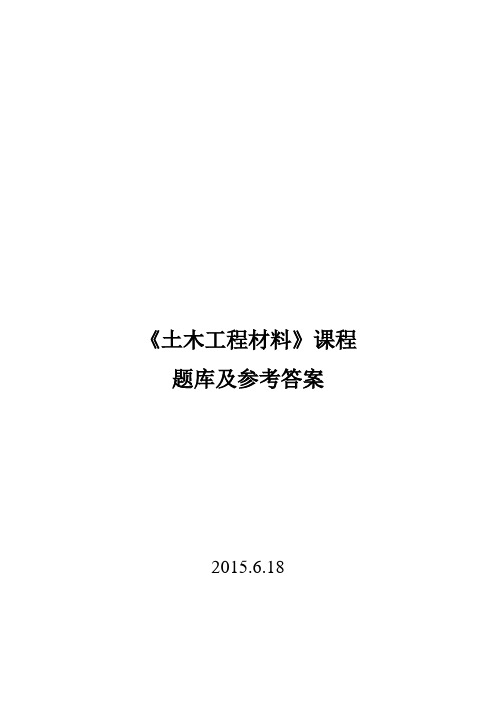
《土木工程材料》课程题库及参考答案2015.6.18绪论部分一、名词解释1、产品标准2、工程建设标准参考答案:1、产品标准:是为保证产品的适用性,对产品必须达到的某些或全部要求所指定的标准。
其范围包括:品种、规格、技术性能、试验方法、检验规则、包装、储藏、运输等。
建筑材料产品,如各种水泥、陶瓷、钢材等均有各自的产品标准。
2、工程建设标准:是对基本建设中各类的勘察、规划设计、施工、安装、验收等需要协调统一的事项所指定的标准。
与选择和使用建筑材料有关的标准,有各种结构设计规范、施工及验收规范等。
二、填空题1、根据组成物质的种类及化学成分,将土木工程材料可以分为、和三类。
2、我国的技术标准分为、、和四级。
参考答案:1、无机材料、有机材料、复合材料;2、国家标准、行业标准、地方标准、企业标准三、简答题1、简述土木工程材料的发展趋势。
2、实行标准化的意义有哪些?3、简述土木工程材料课程学习的基本方法与要求以及实验课学习的意义。
参考答案:1、土木工程材料有下列发展趋势:1)高性能化。
例如研制轻质、高强、高耐久、优异装饰性和多功能的材料,以及充分利用和发挥各种材料的特性,采用复合技术,制造出具有特殊功能的复合材料。
2)多功能化。
具有多种功能或智能的土木工程材料。
3)工业规模化。
土木工程材料的生产要实现现代化、工业化,而且为了降低成本、控制质量、便于机械化施工,生产要标准化、大型化、商品化等。
4)生态化。
为了降低环境污染、节约资源、维护生态平衡,生产节能型、利废型、环保型和保健型的生态建材,产品可再生循环和回收利用。
2、实行标准化对经济、技术、科学及管理等社会实践有着重要意义,这样就能对重复性事物和概念达到统一认识。
以建筑材料性能的试验方法为例,如果不实行标准化,不同部门或单位采用不同的试验方法。
则所得的试验结果就无可比性,其获得的数据将毫无意义。
所以,没有标准化,则工程的设计、产品的生产及质量的检验就失去了共同依据和准则。
金属材料力学性能的五个指标

金属材料力学性能的五个指标
力学性能的五个指标:
1、脆性
脆性是指材料在损坏之前没有发生塑性变形的一种特性。
它与韧性和塑性相反。
脆性材料没有屈服点,有断裂强度和极限强度,并且二者几乎一样。
铸铁、陶瓷、混凝土及石头都是脆性材料。
与其他许多工程材料相比,脆性材料在拉伸方面的性能较弱,对脆性材料通常采用压缩试验进行评定。
2、强度
金属材料在静载荷作用下抵抗永久变形或断裂的能力。
同时,它也可以定义为比例极限、屈服
强度、断裂强度或极限强度。
没有一个确切的单一参数能够准确定义这个特性。
因为金属的行为随着应力种类的变化和它应用形式的变化而变化。
强度是一个很常用的术语。
3、塑性
金属材料在载荷作用下产生永久变形而不破坏的能力。
塑性变形发生在金属材料承受的应力超过弹性极限并且载荷去除之后,此时材料保留了一部分或全部载荷时的变形。
4、硬度
金属材料表面抵抗比他更硬的物体压入的能力。
5、韧性
金属材料抵抗冲击载荷而不被破坏的能力。
韧性是指金属材料在拉应力的作用下,在发生断裂前有一定塑性变形的特性。
金、铝、铜是韧性材料,它们很容易被拉成导线。
土木工程材料考试知识点
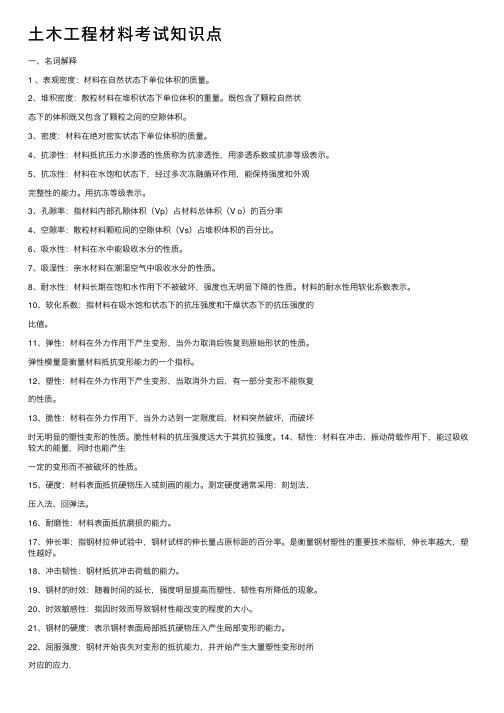
⼟⽊⼯程材料考试知识点⼀、名词解释1 、表观密度:材料在⾃然状态下单位体积的质量。
2、堆积密度:散粒材料在堆积状态下单位体积的重量。
既包含了颗粒⾃然状态下的体积既⼜包含了颗粒之间的空隙体积。
3、密度:材料在绝对密实状态下单位体积的质量。
4、抗渗性:材料抵抗压⼒⽔渗透的性质称为抗渗透性,⽤渗透系数或抗渗等级表⽰。
5、抗冻性:材料在⽔饱和状态下,经过多次冻融循环作⽤,能保持强度和外观完整性的能⼒。
⽤抗冻等级表⽰。
3、孔隙率:指材料内部孔隙体积(Vp)占材料总体积(V o)的百分率4、空隙率:散粒材料颗粒间的空隙体积(Vs)占堆积体积的百分⽐。
6、吸⽔性:材料在⽔中能吸收⽔分的性质。
7、吸湿性:亲⽔材料在潮湿空⽓中吸收⽔分的性质。
8、耐⽔性:材料长期在饱和⽔作⽤下不被破坏,强度也⽆明显下降的性质。
材料的耐⽔性⽤软化系数表⽰。
10、软化系数:指材料在吸⽔饱和状态下的抗压强度和⼲燥状态下的抗压强度的⽐值。
11、弹性:材料在外⼒作⽤下产⽣变形,当外⼒取消后恢复到原始形状的性质。
弹性模量是衡量材料抵抗变形能⼒的⼀个指标。
12、塑性:材料在外⼒作⽤下产⽣变形,当取消外⼒后,有⼀部分变形不能恢复的性质。
13、脆性:材料在外⼒作⽤下,当外⼒达到⼀定限度后,材料突然破坏,⽽破坏时⽆明显的塑性变形的性质。
脆性材料的抗压强度远⼤于其抗拉强度。
14、韧性:材料在冲击、振动荷载作⽤下,能过吸收较⼤的能量,同时也能产⽣⼀定的变形⽽不被破坏的性质。
15、硬度:材料表⾯抵抗硬物压⼊或刻画的能⼒。
测定硬度通常采⽤:刻划法、压⼊法、回弹法。
16、耐磨性:材料表⾯抵抗磨损的能⼒。
17、伸长率:指钢材拉伸试验中,钢材试样的伸长量占原标距的百分率。
是衡量钢材塑性的重要技术指标,伸长率越⼤,塑性越好。
18、冲击韧性:钢材抵抗冲击荷载的能⼒。
19、钢材的时效:随着时间的延长,强度明显提⾼⽽塑性、韧性有所降低的现象。
20、时效敏感性:指因时效⽽导致钢材性能改变的程度的⼤⼩。
名词解释

名词解释1.塑性:材料在外力作用下的变形在外力卸去后能保持。
2. 2.材料的空隙率:散粒材料在堆积状态下单位体积的质量。
3.胶凝材料:将块状材料和散粒材料胶结成一个具有强度的整体的材料。
4.混凝土立方体抗压强度标准值:具有95%保证率的立方体抗压强度。
5.沥青的老化:沥青在阳光、热等因素作用下变硬变脆的过程。
1、抗冻性:材料在饱水状态下抵抗多次冻融循环不破坏、强度也不严重下降的性质。
2、塑性:材料在外力作用下的变形在外力卸去后能保持。
3、碱骨料反应:水泥中的碱和骨料中的活性SIO2之间的化学作用。
4、胶凝材料:将块状材料和散粒材料胶结成一个具有强度的整体的材料。
5、质量吸水率:在吸水饱和状态下材料所吸收水分质量占材料干燥状态质量的百分率。
6、硅酸盐水泥::由硅酸盐水泥熟料、0%-5%的石灰石或粒化高炉矿渣、适量石膏共同磨细所制成的水硬性胶凝材料。
7、砂率:砂的质量占砂石总的质量的百分率。
8、砼强度等级:按混凝土立方体抗压标准强度划分的强度范围。
9、表观密度:在自然状态下,材料单位体积的质量。
10、混凝土外加剂:掺入混凝土中用来改善混凝土性能的物质。
1和易性:指混凝土拌合物易于施工操作、并能活的质量均予、成型密实的混凝土的性能。
2气硬性胶凝材料:在空气中硬化、在空气中保持其强度的胶凝材料。
3弹性:材料在外力作用下的变形在外力卸去后能保持恢复变形之前的形状和尺寸。
4耐久性:材料在长期使用过程中能够保持其原有性质。
5徐变:混凝土在长期荷载作用下随时间而缓慢增长的变形。
6砂率:砂的质量占砂石总的质量的百分率。
7 硅酸盐水泥:由硅酸盐水泥熟料、0%-5%的石灰石或粒化高炉矿渣、适量石膏共同磨细所制成的水硬性胶凝材料。
8 吸湿性:材料在潮湿空气中吸收水份的性质。
1、抗渗性:材料抵抗压力水渗透的能力。
2、脆性:材料在外力作用下发生突然的破坏,破坏之前没有明显的塑性变形。
3、碱骨料反应:水泥中的碱和骨料中的活性SIO2之间的化学作用。
材料力学填空与判断题解总括

F122-题132-题第 2 章 轴向拉伸与压缩二、填空题2-6 承受轴向拉压的杆件,只有在(加力端一定距离外)长度范围内变形才是均匀的。
2-7 根据强度条件][σσ≤可以进行(强度校核、设计截面、确定许可载荷)三方面的强度计算。
2-8 低碳钢材料由于冷作硬化,会使(比例极限)提高,而使(塑性)降低。
2-9 铸铁试件的压缩破坏和(切)应力有关。
2-10 构件由于截面的(形状、尺寸的突变)会发生应力集中现象。
三、选择题2-11 应用拉压正应力公式AN =σ的条件是( B )(A )应力小于比极限;(B )外力的合力沿杆轴线; (C )应力小于弹性极限;(D )应力小于屈服极限。
2-12 图示拉杆的外表面上有一斜线,当拉杆变形时,斜线将( D ) (A )平动;(B )转动;(C )不动;(D )平动加转动。
2-13 图示四种材料的应力-应变曲线中,强度最大的是材料(A ),塑性最好的是材料(D )。
2-14 图示三杆结构,欲使杆3的内力减小,应该( B )DC BA ζε(A )增大杆3的横截面积; (B )减小杆3的横截面积; (C )减小杆1的横截面积; (D )减小杆2的横截面积。
2-15 图示有缺陷的脆性材料拉杆中,应力集中最严重的是杆( D )二、填空题3-6 圆杆扭转时,根据(切应力互等定理),其纵向截面上也存在切应力。
3-7 铸铁圆杆发生扭转破坏的破断线如图所示,试画出圆杆所受外力偶的方向。
3-8 画出圆杆扭转时,两种截面的切应力分布图。
3-9 在计算圆柱形密围螺旋弹簧簧丝切应力时,考虑到(剪力引起的切应力及簧丝曲率的影响 ),而加以校正系数。
3-10 开口薄壁杆扭转时,截面上最大切应力发生在(最厚的矩形长边 )处;闭口薄壁杆扭转时,截面上最大切应力发生在( 最小厚度)处.TTF 123题24 F FF FFFF F(A )(B ) (C )(D )第3章 扭转三,选择题3-11阶梯圆轴的最大切应力发生在( D ) (A) 扭矩最大的截面; (B)直径最小的截面; (C) 单位长度扭转角最大的截面; (D)不能确定.3-12 空心圆轴的外径为 D ,内径为 d ,D d /=α。
强度理论与塑性、脆性材料
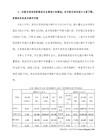
三强度理论所建立的强度条件是:
(s1-s3)≤[s] (1-61)
第四强度理论--首先介绍一下形状改变比能,然后看看强度条件的推导。
物体在外力作用下会发生变形,这里所说的变形,既包括有体积改变也包括有形状改变。当物体因外力作用而产生弹性变形时,外力在相应的位移上就作了功,同时在物体内部也就积蓄了能量。例如钟表的发条(弹性体)被用力拧紧(发生变形),此外力所作的功就转变为发条所积蓄的能。在放松过程中,发条靠它所积蓄的能使齿轮系统和指针持续转动,这时发条又对外作了功。这种随着弹性体发生变形而积蓄在其内部的能量称为变形能。在单位变形体体积内所积蓄的变形能称为变形比能。
由于物体在外力作用下所发生的弹性变形既包括物体的体积改变,也包括物体的形状改变,所以可推断,弹性体内所积蓄的变形比能也应该分成两部分:一部分是形状改变比能md ,一部分是体积改变比能mq 。它们的值可分别按下面的公式计算
md = (1-62)
mq = (1-63)
这两个公式表明,在复杂应力状态下,物体形状的改变及所积蓄的形状改变比能是和三个主应力的差值有关;而物体体积的改变及所积蓄的体积改变比能是和三个主应力的代数和有关。
(2)最大伸长线应变理论(第二强度理论):形式上比第一强度理论完善,但在实际的工程中很少采用。
(3)最大切应力理论(第三强度理论): stress instenstiy
(4)畸变能密度理论(第四强度理论): von mises
注意:
1、对以上四个强度理论的应用,一般说脆性材料如铸铁、混凝土等用第一和第二强度理论;对塑性材料如低碳钢用第三和第四强度理论。
材料力学期末复习题库(你值得看看)
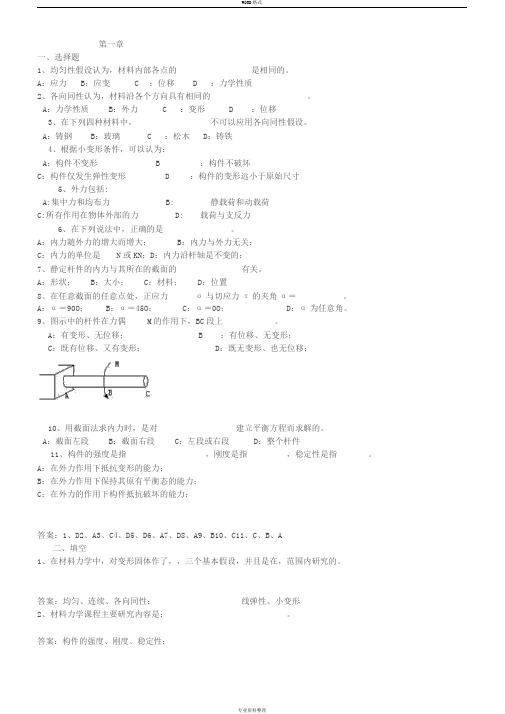
第一章一、选择题1、均匀性假设认为,材料内部各点的是相同的。
A:应力B:应变 C :位移 D :力学性质2、各向同性认为,材料沿各个方向具有相同的。
A:力学性质B:外力 C :变形 D :位移3、在下列四种材料中,不可以应用各向同性假设。
A:铸钢B:玻璃 C :松木D:铸铁4、根据小变形条件,可以认为:A:构件不变形 B :构件不破坏C:构件仅发生弹性变形 D :构件的变形远小于原始尺寸5、外力包括:A:集中力和均布力B: 静载荷和动载荷C:所有作用在物体外部的力D: 载荷与支反力6、在下列说法中,正确的是。
A:内力随外力的增大而增大;B:内力与外力无关;C:内力的单位是N或KN;D:内力沿杆轴是不变的;7、静定杆件的内力与其所在的截面的有关。
A:形状;B:大小;C:材料;D:位置8、在任意截面的任意点处,正应力σ与切应力τ的夹角α=。
A:α=90O;B:α=45O;C:α=0O;D:α为任意角。
9、图示中的杆件在力偶M的作用下,BC段上。
A:有变形、无位移; B :有位移、无变形;C:既有位移、又有变形;D:既无变形、也无位移;10、用截面法求内力时,是对建立平衡方程而求解的。
A:截面左段B:截面右段C:左段或右段D:整个杆件11、构件的强度是指,刚度是指,稳定性是指。
A:在外力作用下抵抗变形的能力;B:在外力作用下保持其原有平衡态的能力;C:在外力的作用下构件抵抗破坏的能力;答案:1、D2、A3、C4、D5、D6、A7、D8、A9、B10、C11、C、B、A二、填空1、在材料力学中,对变形固体作了,,三个基本假设,并且是在,范围内研究的。
答案:均匀、连续、各向同性;线弹性、小变形2、材料力学课程主要研究内容是:。
答案:构件的强度、刚度、稳定性;3、为保证构件正常工作,构件应具有足够的承载力,固必须满足方面的要求。
答案:构件有足够的强度、足够的刚度、足够的稳定性。
4、下列图示中实线代表变形前,虚线代表变形后,角应变为。
混凝土或其他脆性材料的塑性破坏
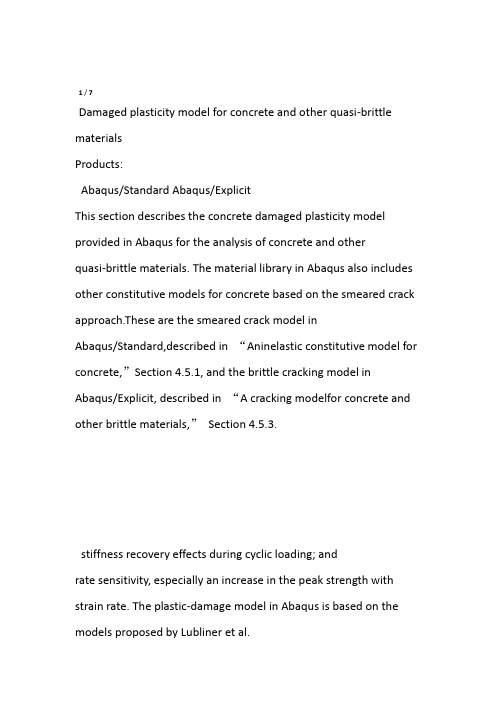
1 / 7Damaged plasticity model for concrete and other quasi-brittle materialsProducts:Abaqus/Standard Abaqus/ExplicitThis section describes the concrete damaged plasticity model provided in Abaqus for the analysis of concrete and otherquasi-brittle materials. The material library in Abaqus also includes other constitutive models for concrete based on the smeared crack approach.These are the smeared crack model inAbaqus/Standard,described in “Aninelastic constitutive model for concrete,”Section 4.5.1, and the brittle cracking model in Abaqus/Explicit, described in “A cracking modelfor concrete and other brittle materials,”Section 4.5.3.stiffness recovery effects during cyclic loading; andrate sensitivity, especially an increase in the peak strength with strain rate. The plastic-damage model in Abaqus is based on the models proposed by Lubliner et al.(1989)and by Lee and Fenves(1998).The model is described in the remainder of this section.An overview of the main ingredients of the model is given first,followed by a more detailed discussion of the different aspects of the constitutive model.Overview2 / 7where is the total strain rate,is the elastic part of the strain rate, and is the plastic part of the strain rate.Stress-strain relationsThe stress-strain relations are governed by scalar damaged elasticity:where is the initial (undamaged)elastic stiffness of the material;is the degraded elastic stiffness; and d is the scalar stiffness degradation variable, which can take values in the range from zero (undamaged material) to one (fully damaged material). Damage associated with the failure mechanisms of the concrete (cracking andcrushing) therefore results in a reduction in the elastic stiffness. Within the context of the scalar-damage theory, the stiffness degradation is isotropic and characterized by a single degradationvariable,d.Following the usual notions of continuum damage mechanics, the effective stress is defined asThe Cauchy stress is related to the effective stress through the scalar degradation relation:For any given cross-section of the material,the factor represents the ratio of the effective load-carrying area (i.e., the overall area minus the damaged area) to the overall section area. In the absence of damage,,the effective stress is equivalent to the Cauchystress, .When damage occurs, however, the effective stress is more representative than the Cauchy stress because it is the effective stress area that is resisting the external loads. It is, therefore, convenient to formulate the plasticity problem in terms of the effective stress.As discussed later,the evolution of the degradation variable is governed by a set of hardening variables, , and the effective stress; that is, .Hardening variablesas described later in this section.Microcracking and crushing in the concrete are represented by increasing values of the hardening variables.These variables control the evolution of the yield surface and the degradation of the elastic stiffness.They are also intimately related to the dissipated fracture energy required to generate micro-cracks.3 / 7Yield functionThe yield function, , represents a surface in effective stress space, whichdetermines the states of failure or damage. For the inviscid plastic-damage modelThe specific form of the yield function is described later in this section. Flow rulePlastic flow is governed by a flow potential G according to the flow rule: where is the nonnegative plastic multiplier. The plastic potential is defined in the effective stress space.The specific form of the flow potential for the concrete damaged plasticity model is discussed later in this section.The model usesnonassociated plasticity,therefore requiring the solution of nonsymmetric equations.SummaryIn summary, the elastic-plastic response of the concrete damaged plasticity model is described in terms of the effective stress and the hardening variables:where and F obey the Kuhn-Tucker conditions:The Cauchy stress is calculated in terms of the stiffness degradation variable, , and the effective stress asThe constitutive relations for the elastic-plastic response,Equation4.5.2–1,aredecoupled from the stiffness degradation response,Equation 4.5.2–2,which makes the model attractive for an effective numerical implementation. The inviscid model summarized here can be extended easily to account for viscoplastic effects through the use of a viscoplastic regularization by permitting stresses to be outside the yield surface.Damage and stiffness degradationThe evolution equations of the hardening variables and are conveniently formulated by considering uniaxial loading conditions first and then extended to multiaxial conditions.Uniaxial conditions 4 / 7It is assumed that the uniaxial stress-strain curves can be converted into stress versus plastic strain curves of the formUnder uniaxial loading conditions the effective plastic strain rates are given asAs shown in Figure 4.5.2–1, when the concrete specimen is unloaded from any point on the strainsoftening branch of the stress-strain curves, the unloading response is observed to be weakened:The effective uniaxial cohesion stresses determine the size of the yield (or failure) surface.Uniaxial cyclic conditionsThe concrete damaged plasticity model assumes that the reduction of the elastic modulus is given in terms of a scalar degradation variable, d, aswhere is the initial (undamaged) modulus of the material.where and are functions of the stress state that are introduced to represent stiffness recovery effects associated with stress reversals. They are defined according towhereThe evolution equations of the equivalent plastic strains are also generalized to the uniaxial cyclic conditions asThe evolution equations for the hardening variables must be extended for the general multiaxial conditions. Based on Lee and Fenves5 / 7(1998) we assume that the equivalent plastic strain rates are evaluated according to the expressionswhere and are, respectively, the maximum and minimumeigenvalues of the plastic strain rate tensor andIf the eigenvalues of the plastic strain rate tensor () are ordered such that , the evolution equation for general multiaxial stress conditions can be expressed in the following matrix form:whereandElastic stiffness degradationThe plastic-damage concrete model assumes that the elastic stiffness degradation is isotropic and characterized by a single scalar variable, d:similar to the uniaxial cyclic case, only that and are now given in terms of the function as It can be easily verified that Equation4.5.2–10for the scalar degradation variable is consistent with the uniaxial response.and .Yield conditionThe plastic-damage concrete model uses a yield condition based on the yield function proposed by Lubliner et al.(1989) and incorporates the modifications proposed by Lee and Fenveswhere and are dimensionless material constants; is the effectivehydrostatic pressure; is the Mises equivalent effective stress;6 / 7is the deviatoric part of the effective stress tensor ; and is the algebraically maximum eigenvalue of . The function is given as Typical experimental values of the ratio for concrete are in the range from 1.10 to 1.16, yielding values of between 0.08 and 0.12 (Lubliner et al., 1989).Let for any given value of the hydrostatic pressure with ; thenThe fact that is constant does not seem to be contradicted by experimental evidence (Lubliner et al., 1989). The coefficient is, therefore, evaluated asA value of , which is typical for concrete, givesLet for any given value of the hydrostatic pressure with ; then Typical yield surfaces are shown in Figure 4.5.2–4 in the deviatoric plane and in Figure 4.5.2–5for plane-stress conditions.Figure 4.5.2–4 Yield surfaces in the deviatoric plane, corresponding to different values of .Figure 4.5.2–5 Yield surface in plane stress. Flow ruleThe plastic-damage model assumes nonassociated potential flow, The flow potential G chosen for this model is the Drucker-Prager hyperbolic function:where is the dilation angle measured in the p–q plane at highconfing pressure;is the uniaxial tensile stress at failure; and is a parameter, referred to as theeccentricity, that defines the rate at which the function approaches the asymptote (the flow potential tends to a straight line as the eccentricity tends to zero). This flow potential, which is continuous and smooth, ensures that the flow direction is defined uniquely.The function asymptotically approaches the linear Drucker-Prager flow potential at high confing pressure stress and intersects the hydrostatic pressure axis at 90°.See “Modelsfor granular or polymer behavior,”Section 4.4.2,for further discussion of this potential.7 / 7Because plastic flow is nonassociated, the use of theplastic-damage concrete model requires the solution of nonsymmetric equations.Viscoplastic regularizationHere is the viscosity parameter representing the relaxation time of theviscoplastic system and is the plastic strain evaluated in the inviscid backbone model. Similarly, a viscous stiffness degradation variable, , for the viscoplastic system is defined as where d is the degradation variable evaluated in the inviscid backbone model.The stress-strainrelation of the viscoplastic model is given asIntegration of the modelThe model is integrated using the backward Euler method generally used with the plasticity models in Abaqus.A material Jacobian consistent with this integration operator is used for the equilibrium iterations.。
材料力学填空与判断题解
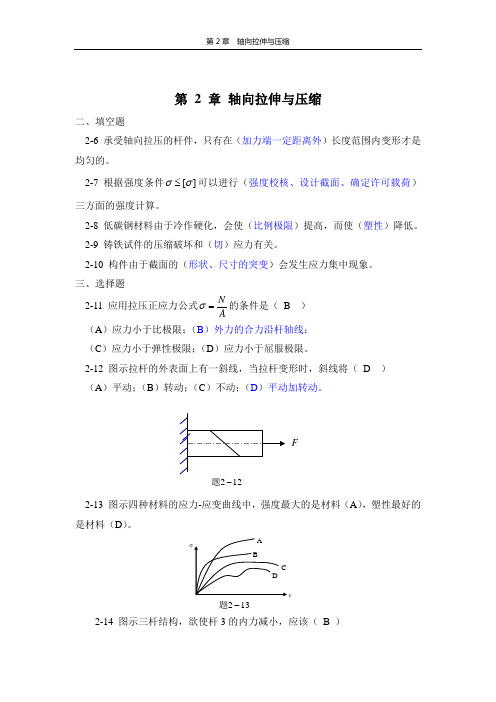
F122-题132-题第 2 章 轴向拉伸与压缩二、填空题2-6 承受轴向拉压的杆件,只有在(加力端一定距离外)长度范围内变形才是均匀的。
2-7 根据强度条件][σσ≤可以进行(强度校核、设计截面、确定许可载荷)三方面的强度计算。
2-8 低碳钢材料由于冷作硬化,会使(比例极限)提高,而使(塑性)降低。
2-9 铸铁试件的压缩破坏和(切)应力有关。
2-10 构件由于截面的(形状、尺寸的突变)会发生应力集中现象。
三、选择题2-11 应用拉压正应力公式AN=σ的条件是( B ) (A )应力小于比极限;(B )外力的合力沿杆轴线; (C )应力小于弹性极限;(D )应力小于屈服极限。
2-12 图示拉杆的外表面上有一斜线,当拉杆变形时,斜线将( D ) (A )平动;(B )转动;(C )不动;(D )平动加转动。
2-13 图示四种材料的应力-应变曲线中,强度最大的是材料(A ),塑性最好的是材料(D )。
2-14 图示三杆结构,欲使杆3的内力减小,应该( B )(A )增大杆3的横截面积; (B )减小杆3的横截面积; (C )减小杆1的横截面积; (D )减小杆2的横截面积。
2-15 图示有缺陷的脆性材料拉杆中,应力集中最严重的是杆( D )第 3 章 扭转二、填空题3-6 圆杆扭转时,根据(切应力互等定理),其纵向截面上也存在切应力。
3-7 铸铁圆杆发生扭转破坏的破断线如图所示,试画出圆杆所受外力偶的方向。
3-8 画出圆杆扭转时,两种截面的切应力分布图。
3-9 在计算圆柱形密围螺旋弹簧簧丝切应力时,考虑到(剪力引起的切应力及簧丝曲率的影响 ),而加以校正系数。
题24(A (B (C )(D第3章 扭转3-10 开口薄壁杆扭转时,截面上最大切应力发生在(最厚的矩形长边 )处;闭口薄壁杆扭转时,截面上最大切应力发生在( 最小厚度)处. 三,选择题3-11阶梯圆轴的最大切应力发生在( D ) (A) 扭矩最大的截面; (B)直径最小的截面; (C) 单位长度扭转角最大的截面; (D)不能确定.3-12 空心圆轴的外径为 D ,内径为 d ,D d /=α。
材料在拉伸和压缩时的力学性能

表6-3 几种常用材料在常温与静载下的力学性能
6.4.3 工程材料的选用原则
综上所述,根据塑性材料和脆性材料的力学性能,可按照以下思想选择工 程材料。
① 塑性材料适于制作需进行锻压、冷拉或受冲击荷载、动力荷载的构件, 而脆性材料则不能。因为塑性材料的延ห้องสมุดไป่ตู้率大、塑性好,而脆性材料的延伸率 小、塑性差。
图6-14b
(2) 屈服阶段
当材料屈服时,如果试件表面经过磨光,则在光滑的试件表面会出现与轴 线约成 45o 倾角的斜纹,如图6-15a 所示。这种条纹是由于材料的微小晶粒之间 产生滑移而形成的,称为滑移线。考虑到轴向拉伸时,在与杆轴线成 45o 的斜截 面上,剪应力最大,可知屈服现象的出现,与最大剪应力有关。当应力达到屈服 极限时,材料会出现过大的塑性变形,将使构件不能正常工作,所以屈服极限 σs 是衡量材料强度的一个重要指标。低碳钢的屈服极限应力约为σs = 235 MPa,所 以低碳钢又称为 Q235 钢。
① 在应力未超过屈服阶段前,两个图形是 重合的。因此,受压时的弹性模量E、比例极限 σp 和屈服极限 σs 与受拉时相同。
图6-17
② 当应力超过屈服极限后,受压的曲线不断上升,其原因是试件的截面不断 增加,由鼓形最后变成了薄饼形,如图6-17 所示。
由于钢材受拉和受压时的主要力学性能 ( E、σp、σs ) 相同, 所以钢材的力 学性能都由拉伸试验来测定,不必进行压缩试验。
l1 l 100% l
延伸率 δ 是衡量材料塑性的一个指标。低 碳钢的 δ = 25% ~ 27%。
图6-14b
工程中使用的材料种类很多,习惯上根据试件在破坏时塑性变形的大 小,将材料分为塑性材料和脆性材料两类。 δ ≥ 5% 的材料称塑性材料,如 钢、铜、铝等;δ < 5% 的材料的称脆性材料,如铸铁、玻璃、石料、混凝 土等。需要指出的是,材料的力学性能不是固定不变的,随着材料所处条 件的不同,其力学性能可能会发生改变。
土木工程材料练习题及答案

土木工程材料练习题一、单选选择题1. 测试混凝土静力受压弹性模量时标准试件的尺寸为()。
A 150×150×150mmB 40×40×160mmC 70.7×70.7×70.7mmD 150×150×300mm2. 表示普通混凝土(非干硬性)流动性的指标为()。
A 坍落度B 分层度C 沉入度D 维勃稠度3. 石灰熟化过程中的陈伏是为了()。
A.利于结晶B.蒸发多余水分C.消除过火石灰的危害D.降低发热量4. 砂浆的流动性指标为()。
A 坍落度B 分层度C 沉入度D 维勃稠度5. 石油沥青的粘性是以()表示的。
A 针入度B 延度C 软化点D 溶解度6. 下列碳素结构钢中含碳量最高的是( )。
A.Q235-AFB.Q215C.Q255D.Q2757. 下列水泥中,耐磨性最好的是()。
A 硅酸盐水泥B 粉煤灰水泥C 矿渣水泥D 火山灰水泥8. 表示干硬性混凝土流动性的指标为()。
A 坍落度B 分层度C 沉入度D 维勃稠度9. 检验水泥中f-CaO是否过量常是通过()。
A 压蒸法B 长期温水中C 沸煮法D 水解法10. 现场拌制混凝土,发现粘聚性不好时最可行的改善措施为()A 适当加大砂率B 加水泥浆(W/C不变)C 加大水泥用量D 加CaSO411. 烧结普通砖在墙体中广泛应用,主要是由于其具有下述除()外的各性能特点。
A 一定的强度 B 高强C 耐久性较好D 隔热性较好二、填空题1.硅酸盐水泥的强度等级可以分为_______,_______,_______,_______,_______,_______,其中R代表_______2. 火山灰硅酸盐水泥的强度等级可以分为_______,_______,_______,_______,_______,_______,其中R代表_______3. 普通混凝土配合比设计中要确定的三个参数为、和 .4. 按国家标准的规定,硅酸盐水泥的初凝时间应满足__________________,终凝时间应满足__________________。
本-混凝土结构理论客观题

在长期荷载作用下,引起受弯构件变形增大的主要原因是A.构件中未设受压钢筋B.混凝土徐变和收缩C.裂缝宽度增大D.钢筋与混凝土之间的滑移回答错误! 正确答案: B永久荷载的代表值是A.频遇值B.组合值C.标准值D.准永久值回答错误! 正确答案: C提高梁的配箍率可以A.防止斜压破坏B.提高斜裂缝开裂荷载C.使斜压破坏转化为剪压破坏D.提高抗剪承载力回答错误! 正确答案: D当N2<N1< Nb(界限轴力),M1>M2时,钢筋混凝土受压柱采用对称配筋,下面哪组内力计算的配筋最大A.N1,M1B.N2,M2C.N1,M2D.N2,M1回答错误! 正确答案: B构件上施加的预应力属于A.动荷载B.永久荷载C.偶然荷载D.可变荷载回答错误! 正确答案: B对T 型截面,当时,其截面承载力应按下列哪种分类计算A.双筋截面B.第二类T 型截面C.以上都不是D.第一类T 型截面回答错误! 正确答案: D大小偏心受压破坏的分本区别是A.破坏时受压钢筋是否屈服B.偏心距的大小C.破坏时受拉钢筋是否屈服D.受压一侧混凝土是否达到极限压应变回答错误! 正确答案: C受拉钢筋应变不均匀系数Ψ 越大,表明A.裂缝间钢筋平均应变越小B.与裂缝间受拉混凝土参加工作程度无关C.裂缝间受拉混凝土参加工作程度越大D.裂缝间受拉混凝土参加工作程度越小回答错误! 正确答案: D当N1>N2>N b(界限轴力),M1>M2 时,钢筋混凝土受压柱采用对称配筋,下面哪组内力计算的配筋最大A.N2,M1B.N1,M2C.N1,M1D.N2,M2回答错误! 正确答案: C永久荷载代表值采用A.组合值B.标准值C.准永久值D.频域值回答错误! 正确答案: B设计使用年限为50 年的结构构件,结构重要性系数不应小于A.1.1B.1.2C.1.0D.0.9回答错误! 正确答案: C 斜截面受剪破坏形态中属于延性破坏的是A.以上都不是B.剪压破坏C.斜压破坏D.斜拉破坏回答错误! 正确答案: A 对于正截面受弯构件,下列说法正确的是A.双筋矩形截面中,受压钢筋增强了构件的承载力,但降低了构件的延性B.双筋矩形因配有受压钢筋,因此截面不会出现超筋破坏C.构件为适筋梁时,混凝土强度对受弯构件承载力影响比钢筋强度小的多D.截面配筋率越大,构件的承载力和延性越好回答错误! 正确答案: C 钢筋混凝土弯剪扭构件承载力计算考虑哪两种内力的相关性A.弯矩和轴力B.弯矩和剪力C.弯矩和扭矩D.剪力和扭矩回答错误! 正确答案: D 以下混凝土构件破坏属于明显脆性破坏性质的是A.小偏压破坏B.大偏压破坏C.适筋破坏D.部分超筋破坏回答错误! 正确答案: A下列属于可变荷载的有A.爆炸B.地震作用C.结构自重D.风荷载回答错误! 正确答案: D 对于弯剪扭构件,下列说法不正确的是A.主要通过引入折减系数分别对受剪和受剪承载力修正已考虑剪扭相关性B.仅对混凝土部分考虑其剪扭相关性C.计算时可对钢筋贡献的抗力采用简单叠加的方法D.构件的剪扭相关性主要考虑了箍筋在抵抗剪力时的重叠作用回答错误! 正确答案: D 斜截面破坏承载力主要与混凝土抗压强度有关的破坏形式是A.斜压破坏B.剪压破坏C.偏压破坏D.斜拉破坏回答错误! 正确答案: B受弯构件裂缝宽度和变形验算是以下列哪个状态为依据的A.I IIB.IaC.IID.IIIa回答错误! 正确答案: C下列对应正常使用承载能力极限状态验算的是A.柱子被压屈B.连续倒塌C.油罐结构开裂D.疲劳破坏回答错误! 正确答案: C剪跨比λ< 1,且配箍率式中的受剪破坏形态为A.剪压破坏B.斜拉破坏C.斜压破坏D.超筋破坏回答错误! 正确答案: C对不可逆正常使用极限状态验算时,荷载取A.基本组合B.准永久组合C.偶然组合D.标准组合回答错误! 正确答案: D关于受扭钢筋的构造要求,下列不正确的是A.箍筋应做成封闭型B.纵筋间距不应大于200mmC.优先选用受力性能较好的复合箍筋D.纵筋布置以沿截面周边均匀、对称回答错误! 正确答案: C为节省钢筋,若受压钢筋AˊS 未知时,双筋矩形截面设计时需补充下列条件A.以上都不对B.x =2aˊsC.ξ=ξ bD.As =ρ bhmin 0回答错误! 正确答案: C下列哪种特性不是钢筋混凝土的优点A.抗裂性好B.耐火性好C.可模型好D.耐久性好回答错误! 正确答案: A为防止发生斜截面受弯破坏,要求满足A.最大箍筋间距B.最小箍筋直径C.构造要求a≥ 0.5h0D.最小配箍率回答错误! 正确答案: C对于1<λ<3 的钢筋混凝土梁,下列论述正确的是A.若腹筋过少时,可能发生斜拉破坏B.无论腹筋数量多少都将发生剪压破坏C.若无腹筋时将发生剪压破坏D.无论腹筋数量多少都不会发生斜压破坏回答错误! 正确答案: C普通房屋和构筑物设计使用年限为A.100 年B.25 年回答错误! 正确答案: C剪跨比λ 对无腹筋梁破坏性态和受剪承载力影响,下列说法不正确的是A.λ 过小,荷载主要依靠压应力传递到支座B.λ 过大,荷载主要依靠拉应力传递到支座C.随剪跨比λ 的不断增大,受剪承载持续降低很快D.λ 实质是反映了截面弯矩与剪力的荷载组合情况回答错误! 正确答案:C 采用预应力构件的优势不包括下面A.减小构件截面尺寸,减轻自重B.具有良好的裂缝闭合性能C.提高构件截面极限承载力D.提高截面疲劳强度回答错误! 正确答案: C 受弯构件极限承载力验算是以下列哪个状态为依据的C.IaD.IIIa回答错误! 正确答案: D 对可逆正常使用极限状态验算时,荷载取A.标准组合B.偶然组合C.基本组合D.准永久组合回答错误! 正确答案: DHPB钢筋指的是下列那组钢筋系列A.细晶粒热轧钢筋B.热轧带肋钢筋C.余热处理钢筋D.热轧光圆钢筋回答错误! 正确答案: D下列对梁截面破坏性态的描述属于超筋梁的是A.受拉钢筋屈服的同时,受压区混凝土被压碎B.混凝土开裂的同时,钢筋即屈服并进入强化阶段,或者被拉断C.受拉钢筋先屈服,受压区混凝土后被压碎D.受压区混凝土先被压碎,受拉钢筋未屈服回答错误! 正确答案: D混凝土的徐变和收缩会使钢筋混凝土轴压短柱的极限承载力A.增大B.均有可能C.没有影响D.减小回答错误! 正确答案: C混凝土标号C40中的数字40 表示其A.棱柱体抗压强度标准值B.立方体抗压强度标准值C.轴心抗压强度设计值D.轴心受拉强度标准值回答错误! 正确答案: B 小偏心受压构件设计时(纵向偏心压力N<fcbh )A.取x=2aˊs,采取下列何种措施最经济B.取C.取A=Aˊs sD.取As=ρ minbh回答错误! 正确答案: D以下混凝土构件破坏不属于脆性破坏的是A.小偏压破坏B.剪压破坏C.少筋梁破坏D.大偏压破坏回答错误! 正确答案: D纯扭构件通过什么条件避免出现少筋破坏A.截面尺寸限制B.最小纵筋配筋率C.最小配箍率回答错误! 正确答案: D剪跨比1<λ< 3 的无腹筋梁破坏形态为A.超筋破坏B.斜压破坏C.剪压破坏D.斜拉破坏回答错误! 正确答案: C影响正截面破坏的主要因素为A.配筋率B.以上都包括C.混凝土强度D.钢筋强度回答错误! 正确答案: B构件上施加的预应力属于A.偶然荷载C.永久荷载D.可变荷载回答错误! 正确答案: C下列对应正常使用承载能力极限状态验算的是A.疲劳破坏B.连续倒塌C.构件挠度D.材料破坏混凝土构件承载力计算时采用的抗压强度指标为A.三向轴压强度B.双向轴压强度C.轴心抗压强度D.立方体抗压强度回答错误! 正确答案: C当受扭构件的纵筋和箍筋配筋强度比ζ 为下列那个值时会发生部分超筋破坏B.0.6C. 1.0D.0.3回答错误! 正确答案: D以下哪项不属于防止超筋梁的使用条件A.B.C.D.回答错误! 正确答案: D关于梁截面裂缝宽度的论述,下列说法不正确的是A.最大裂缝宽度考虑了材料的不均匀性和长期作用影响B.我国规范综合了粘结滑移理论和无滑移理论的模式,并通过试验确定了相关C.随着荷载的增加,梁截面会不断的增加新的裂缝D.保护层厚度越大,裂缝最大宽度越大回答错误! 正确答案:C轴心受压短柱需要限制最大配筋率的原因A.避免斜压破坏B.突然卸载引起混凝土和钢筋回弹C.长期荷载作用引起混凝土徐变D.避免超筋破坏回答错误! 正确答案:B雪荷载属于下列哪种荷载A.动荷载B.可变荷载C.偶然荷载D.永久荷载回答错误! 正确答案:B下列对梁截面破坏性态的描述属于少筋梁的是A.混凝土开裂的同时,钢筋即屈服并进入强化阶段,或者被拉断B.受拉钢筋先屈服,受压区混凝土后被压碎C.受拉钢筋屈服的同时,受压区混凝土被压碎D.受压区混凝土先被压碎,受拉钢筋未屈服钢筋混凝土塑性铰特点下列哪种说法不正确A.能够承担弯矩B.仅能沿弯矩方向转动C.形成塑性区域D.能够自由转动回答错误! 正确答案: D构件进行极限承载能力设计时采用A.荷载平均值B.荷载准永久值C.荷载标准值D.荷载设计值有腹筋剪扭构件的剪扭承载力A.混凝土和钢筋部分都相关B.混凝土部分相关,钢筋部分不相关C.混凝土和钢筋部分都不相关D.混凝土部分不相关,钢筋部分相关回答错误! 正确答案: B 钢筋混凝土构件的裂缝间距主要影响因素为A.混凝土与钢筋间的粘结强度有关B.混凝土极限拉应变C.混凝土回缩及钢筋伸长量D.混凝土抗拉强度回答错误! 正确答案: C配置受压钢筋的梁长期刚度大一些,主要原因是A.裂缝宽度增大B.减小了受压区高度C.可减少混凝土收缩和徐变对挠度的影响D.增加了延性简支梁在集中荷载作用下的计算剪跨比a/h0 反映了A.截面上正应力σ 与剪应力τ 的比值关系B.荷载的大小C.构件的几何尺寸关系D.梁的支撑条件回答错误! 正确答案: A受弯构件斜截面受剪承载力的因素主要有A.剪跨比B.配箍率C.混凝土强度D.以上都包括回答错误! 正确答案: D两种以上可变荷载同时作用于结构上时,除主导荷载外,其他伴随荷载代表值采用A.组合值B.标准值C.频域值D.准永久值回答错误! 正确答案: A对于λ>3 的钢筋混凝土梁,下列论述正确的是A.腹筋数量适量时将发生剪压破坏B.无论腹筋数量多少都会发生斜拉破坏C.腹筋数量适量时将发生斜拉破坏D.无论腹筋数量多少都不会发生剪压破坏回答错误! 正确答案: A界限相对受压区高度与下列那些因素有关A.钢筋的面积B.截面的高度C.钢筋的强度D.截面的宽度回答错误! 正确答案: C设计使用年限为100 年的结构构件,结构重要性系数不应小于A.0.9B.1.0C.1.1D.1.2回答错误! 正确答案: C 下列对梁截面破坏性态的描述属于适筋梁的是A.混凝土开裂的同时,钢筋即屈服并进入强化阶段,或者被拉断B.受压区混凝土先被压碎,受拉钢筋未屈服C.受拉钢筋先屈服,受压区混凝土后被压碎D.受拉钢筋屈服的同时,受压区混凝土被压碎回答错误! 正确答案: C纪念性建筑的设计使用年限为A.25 年B.5 年C.50D.100 年回答错误! 正确答案: D 对钢筋混凝土结构耐久性没有影响的是A.钢筋的强度B.混凝土强度C.混凝土的碳化D.钢筋的锈蚀回答错误! 正确答案: A 改善梁截面的曲率延性的措施之一是A.增加AsB.增加AˊsC.以上都包括D.提高钢筋强度等级回答错误! 正确答案: B下列对应于承载能力极限状态验算的是A.裂缝宽度过大B.结构倾覆C.门窗变形D.振动较大回答错误! 正确答案: B立方体抗压强度测定采用的标准立方体试件边长为A.200mmB.150mmC.100mmD.180mm回答错误! 正确答案: B钢筋混凝土梁的配筋率在等于最大配筋率时发生破坏称为A.适筋破坏B.少筋破坏C.界限破坏D.超筋破坏回答错误! 正确答案: C 下列能用来判断梁是否超筋的参数是A.相对受压区高度B.截面弹塑性抵抗矩系数C.以上都可以D.配筋率回答错误! 正确答案: C剪跨比λ 对无腹筋梁受剪承载力影响规律为A.随剪跨比λ 增加,承载力不断降低B.随剪跨比λ 增加,承载力初始降低,到一定程度后趋于稳定C.随剪跨比λ 增加,承载力不断提高D.随剪跨比λ 增加,承载力初始增加,到一定程度后趋于稳定回答错误! 正确答案: B 斜截面受剪承载力计算是以下列那种破坏形态为依据的A.偏压破坏B.斜拉破坏C.斜压破坏D.剪压破坏回答错误! 正确答案: D 影响无腹筋梁受剪破坏形态的主要因素是A.纵筋配筋强度B.剪跨比C.纵筋配筋率D.混凝土强度回答错误! 正确答案: B纯扭构件通过什么条件避免出现完全超筋破坏A.最小纵筋配筋率B.最小配箍率C.配筋强度比ζD.截面尺寸限制回答错误! 正确答案: D受压构件离轴力较远筋先达到屈服,然后另一侧混凝土被压碎的破坏形式称为A.少筋梁破坏B.小偏压破坏C.大偏压破坏D.剪压破坏回答错误! 正确答案: C钢筋混凝土梁塑性铰特性包含下列那个选项A.集中在一个点B.能够自由转动C.不能转动D.能够承担弯矩关于配有螺旋式箍筋柱,下列说法不正确的是A.配置有连续缠绕、间距很密的螺旋式或焊接式箍筋B.螺旋箍筋能有效限制核心混凝土横向变形C.螺旋箍筋其主要作用是为了增加柱的横向抗剪切能力D.套箍作用能使混凝土抗压强度提高回答错误! 正确答案: C 易于替换的结构构件的设计使用年限为A.100 年B.50 年C.5 年D.25 年回答错误! 正确答案: DHRBF钢筋指的是下列那组钢筋系列A.热轧光圆钢筋B.细晶粒热轧钢筋C.热轧带肋钢筋D.余热处理钢筋回答错误! 正确答案: B 下列哪些因素对钢筋和混凝土的粘结有影响A.钢筋的表面形状B.混凝土强度C.横向钢筋D.以上都包括回答错误! 正确答案: D 受弯构件截面开裂验算是以下列哪个状态为依据的A.IIIB.IaC.IID.IIIa回答错误! 正确答案: B纯扭构件通过什么条件避免出现部分超筋破坏A.配筋强度比ζB.最小纵筋配筋率C.截面尺寸限制D.最小配箍率回答错误! 正确答案: A正常使用极限状态验算不包括A.保证耐久性的措施B.变形验算C.裂缝控制验算D.构件失稳验算回答错误! 正确答案: D对T 型截面,当时,其截面承载力应按下列哪种分类计算A.第一类T 型截面B.以上都不是C.第二类T 型截面D.双筋截面回答错误! 正确答案: C当受扭构件的纵筋和箍筋配筋强度比ζ 为下列那个值时会发生部分超筋破坏A. 1.4B. 1.7C.0.6D. 2.2回答错误! 正确答案: D结构应满足的功能要求有A.以上全包括B.适用性C.安全性D.耐久性回答错误! 正确答案: A轴心受压短柱需要限制最小配筋率的原因A.突然卸载引起混凝土和钢筋回弹B.避免超筋破坏C.长期荷载作用引起混凝土徐变D.避免斜压破坏回答错误! 正确答案: C设计矩形截面偏心受压构件时,若初始偏心距ei > 0.3h0, 则构件为A.均有可能B.小偏压构件C.大偏压构件D.界限破坏构件回答错误! 正确答案: A属于混凝土结构的特点是A.质量轻B.抗裂性好C.耐火性差D.整体性好回答错误! 正确答案: D下列哪种梁的纵筋在构件破坏时未达到屈服A.超筋梁B.适筋梁C.少筋梁D.以上都能回答错误! 正确答案: A临时性结构的设计使用年限为A.100 年B.5 年C.25 年D.50 年回答错误! 正确答案: B下列属于可变荷载的有A.地震作用B.结构自重C.风荷载D.爆炸回答错误! 正确答案: C提高钢筋混凝土受弯构件弯曲刚度的有效方法有A.增加构件的配筋B.提高混凝土强度C.增加箍筋数量D.增加截面高度回答错误! 正确答案: D对承载能力极限状态的荷载效应组合,对持久设计状况应采用A.偶然组合B.永久荷载和可变荷载的组合C.基本组合D.标准组合对于λ<1 的钢筋混凝土梁,下列论述正确的是A.无论腹筋数量多少都会发生斜压破坏B.若腹筋过少时,可能发生斜拉破坏C.无论腹筋数量多少都不会发生斜压破坏D.腹筋数量适量时将发生剪压破坏回答错误! 正确答案: A轴心受压构件的稳定系数主要决定于A.混凝土强度B.长细比C.纵筋的配筋率D.钢筋强度回答错误! 正确答案: B衡量混凝土强度大小的基本指标是A.立方体抗压强度B.棱柱体抗压强度C.轴心抗拉强度D.轴心抗压强度回答错误! 正确答案: AT 形或工形截面翼缘的存在对承载力没有提高的是A.斜拉破坏B.以上都有C.剪压破坏D.斜压破坏回答错误! 正确答案: D关于箍筋的作用,下列论述不正确的是A.箍筋可以提高斜压破坏梁的抗剪能力B.箍筋可以提高剪压破坏梁的抗剪能力C.箍筋可以提高纵筋的销栓作用D.箍筋可以限制斜裂缝的延伸和开展回答错误! 正确答案: A梁在斜截面设计中,要求箍筋间距s≤ smax,其目的是A.避免斜裂缝过宽B.保证箍筋发挥作用C.防止发生斜压破坏D.防止发生斜拉破坏回答错误! 正确答案: B下列属于偶然荷载的是A.吊车荷载B.撞击力C.风荷载D.土压力回答错误! 正确答案: B为避免弯剪扭构件出现少筋破坏,采用的控制条件是A.保证受扭纵筋的配筋率B.保证最小配箍率C.以上都包括D.保证弯曲受拉纵筋的配筋率回答错误! 正确答案: C下列对应承载能力极限状态验算的是A.裂缝B.构件挠度C.疲劳破坏D.较大的振动回答错误! 正确答案: C设计对称配筋矩形截面偏心受压构件时,若初始偏心距 e > 0.3h ξ>ξ 则为i 0, b, A.小偏压构件B.大偏压构件C.界限破坏构件D.均有可能回答错误! 正确答案: A超筋梁正截面受弯承载力与A.配筋强度fyAs 有关B.混凝土强度和配筋强度都有关C.混凝土强度和配筋强度都无关D.混凝土强度有关回答错误! 正确答案: D下列哪项对受弯构件斜截面承载力没有影响A.纵筋配筋率B.纵筋配筋强度C.混凝土强度D.剪跨比回答错误! 正确答案: B减小构件裂缝宽度的最有效措施(A.增大混凝土截面面积B.提高混凝土等级C.提高钢筋强度等级D.配筋面积不变,减小钢筋直径回答错误! 正确答案: D 正常使用情况下,钢筋混凝土梁处于哪个阶段A.屈服阶段B.带裂缝工作阶段C.弹性工作阶段D.破坏阶段回答错误! 正确答案: B 设计矩形截面偏心受压构件时,若初始偏心距A.大偏压构件ei < 0.3h0 , 则构件为B.界限破坏构件C.均有可能D.小偏压构件回答错误! 正确答案: D无腹筋梁剪跨比λ>3 时发生的破坏为A.超筋破坏B.剪压破坏C.斜压破坏D.斜拉破坏回答错误! 正确答案: D部分超筋破坏的钢筋混凝土受扭构件的破坏属于A.受拉脆性破坏B.有一定的延性C.延性破坏D.受压脆性破坏钢筋混凝土受扭构件一般应A.只配抗扭箍筋B.配抗扭纵筋和抗扭箍筋C.配与构件轴线成45 度的螺旋箍筋D.只配抗扭纵筋减小构件挠度的最有效措施A. 增大混凝土截面面积B. 增加截面配筋面积C.提高钢筋强度等级D.增大截面高度回答错误! 正确答案:D单筋矩形截面中,受拉区配筋率越高,构件的抗弯承载力越大错误正确荷载长期作用会使刚度降低,因此计算受弯构件挠度时需考虑长期荷载作用的刚度错误正确回答错误! 正确答案:B构件上的预应力属于永久荷载错误正确回答错误! 正确答案:B结构或构件进行承载能力极限状态验算时应采用荷载的标准值错误正确双筋矩形截面受弯破坏性态仅与单筋截面部分有关,仅需控制单筋截面不超筋即可正确错误回答错误! 正确答案:A影响受弯构件正截面承载力的最主要因素是钢筋强度和配筋率错误正确回答错误! 正确答案:B对偏心受压构件来说,轴压力一定时,弯矩越大越不利正确错误回答错误! 正确答案:A《规范》要求受扭构件的纵筋和箍筋配筋强度比0.6 ≤ζ≤ 1 是.7 为了防止部分超筋破坏错误正确回答错误! 正确答案:B适筋梁钢筋屈服后,截面裂缝得到很大程度的发展,因此钢筋屈服后的受力状态是裂缝宽度和挠度计算的依据正确错误回答错误! 正确答案:B为充分利用螺旋箍筋对轴心受压构件受压承载力的增强效果,采用螺旋箍筋后的承载力设计值宜超过按普通箍筋柱承载力的50%以上正确错误回答错误! 正确答案:B无论是剪扭构件或者纯扭构剪中,混凝土部分所分担的抗扭能力均相同错误正确回答错误! 正确答案:A同时受剪力和扭矩作用的构件,其承载力总是低于剪力或扭矩单独作用时的承载力错误正确回答错误! 正确答案: B结构的设计使用年限也就是设计基准期错误正确回答错误! 正确答案: A配置腹筋无法提高钢筋混凝土梁斜压破坏承载能力正确回答错误! 正确答案: B保护层厚度越大,构件裂缝宽度越小,因此可通过增大保护层的方法减小裂缝宽度。
混凝土结构设计原理考试判断题

混凝土结构设计原理二、判断题I. 通常所说的混凝土结构是指素混凝土结构,而不是指钢筋混凝土结构。
(X )2.混凝土结构是以混凝土为主要材料,并根据需要配置钢筋、预应力筋、型钢等,组成承力构件的结构。
(V )3. 我国《混凝土规范》规定:钢筋混凝土构件的混凝土强度等级不应低于C10 o (X )4. 钢筋的伸长率越小,表明钢筋的塑性和变形能力越好。
(X )5. 钢筋的疲劳破坏不属于脆性破坏。
(X )6. 对于延性要求比较高的混凝土结构(如地震区的混凝土结构),优先选用高强度等级的混凝土。
(X )7. 粘结和锚固是钢筋和混凝土形成整体、共同工作的基础。
(V )8. 只存在结构承载能力的极限状态,结构的正常使用不存在极限状态。
(X )9. 一般来说,设计使用年限长,设计基准期可能短一些;设计使用年限短,设计基准期可能长一些。
(X )10. 钢筋和混凝土的强度标准值是钢筋混凝土结构按极限状态设计时采用的材料强度基本代表值。
(V )II. 荷载设计值等于荷载标准值乘以荷载分项系数,材料强度设计值等于材料强度标准值乘以材料分项系数。
(V )12. 混凝土强度等级的选用须注意与钢筋强度的匹配,当采用335、400 钢筋时,为了保证必要的粘结力,混凝土强度等级不应低于C25 ;当采用新400钢筋时,混凝土强度等级不应低于C30o(V )13 .一般现浇梁板常用的钢筋强度等级为235、335钢筋。
(V )14 .混凝土保护层应从受力纵筋的内边缘起算。
(X )15 .钢筋混凝土受弯构件正截面承载力计算公式中考虑了受拉区混凝土的抗拉强度。
(X )16.钢筋混凝土受弯构件斜截面受剪承载力计算公式是以斜拉破坏为基础建立的。
(17 .钢筋混凝土梁斜截面破坏的三种形式是斜压破坏,剪压破坏,斜拉破坏。
(V )18 .钢筋混凝土无腹筋梁发生斜拉破坏时,梁的抗剪强度取决于混凝土的抗拉强度,剪压破坏也基本取决于混凝土的抗拉强度,而发生斜压破坏时,梁的抗剪强度取决于混凝土的抗压强度。
5.12 脆性材料及非金属材料力学性能

5.12 脆性材料及非金属材料力学性能σ(MPa )ε(%)100 500.45σb脆性材料的强度指标是σb0.1灰口铸铁:不抗拉极限应力σb割线弹性模量铸铁拉伸的力学性能1.裂缝 45°2.较高 σb ( 4 倍受拉强度) 3.较大δ, 接近 5% 4.拉压弹性模量不同 E400 σ(MPa )ε3006004%2%压缩 拉伸 铸铁受压可作受压构件常见非金属材料的力学性能混凝土:脆性材料, 抗拉强度较低。
由水泥、沙子、碎石、水、添加剂组成,强度由配合比决定。
例如:水灰比,沙子、碎石质量 ( 细粗骨料),养护时间、温度等。
•强度与加载速率有关;破坏形式与约束有关。
•立方体强度:150*150*150mm•轴心受压强度:150*150*300mm木材——纤维材料•木材属正交各向异性材料,受年轮影响,其顺纹方向的强度要比横纹方向的强度高的多,且其抗拉强度高于抗压强度。
不同种类木材强度差别较大。
顺纹拉伸顺纹压缩横纹压缩σε•同一种类木材,其强度受湿度,形状,年龄,木结分布等影响较大。
玻璃钢、纤维板由玻璃纤维(碳纤维)与树脂粘结而成, 属于复合材料。
•重量轻•比强度高•耐腐蚀•抗震性能好•其力学性能与玻璃纤维•玻璃布和树脂的性能有关•各向异性材料2 塑性材料和脆性材料比较123塑性材料在弹性范围内,应力应变成正比,而脆性材料不具有严格线性关系。
塑性材料屈服前,抗拉和抗压性能基本相同,而脆性材料抗压强度远高于抗拉强度。
塑性材料的力学性能指标有弹性极限、屈服极限、强度极限、伸长率、截面收缩率等,而脆性材料只有强度极限。
4塑性材料断裂时伸长率大,塑性好,而脆性材料伸长率小,塑性差。
2 5 6塑性材料屈服时发生较大塑性变形,但没产生断裂破坏;脆性材料的破坏形式为突发性脆断。
塑性材料承受动荷载的能力强,而脆性材料承 受动荷载的能力差。
有缘学习更多+谓ygd3076考证资料或关注桃报:奉献教育(店铺)。
- 1、下载文档前请自行甄别文档内容的完整性,平台不提供额外的编辑、内容补充、找答案等附加服务。
- 2、"仅部分预览"的文档,不可在线预览部分如存在完整性等问题,可反馈申请退款(可完整预览的文档不适用该条件!)。
- 3、如文档侵犯您的权益,请联系客服反馈,我们会尽快为您处理(人工客服工作时间:9:00-18:30)。
Damaged plasticity model for concrete and other quasi-brittle materialsProducts:Abaqus/Standard Abaqus/ExplicitThis section describes the concrete damaged plasticity model provided in Abaqus for the analysis of concrete and other quasi-brittle materials. The material library in Abaqus also includes other constitutive models for concrete based on the smeared crack approach.These are the smeared crack model inAbaqus/Standard,described in “Aninelastic constitutive model for concrete,”Section 4.5.1, and the brittle cracking model in Abaqus/Explicit, described in “A cracking modelfor concrete and other brittle materials,” Section 4.5.3.stiffness recovery effects during cyclic loading; andrate sensitivity, especially an increase in the peak strength with strain rate.The plastic-damage model in Abaqus is based on the models proposed by Lubliner et al.(1989)and by Lee and Fenves(1998).The model is described in the remainder of this section.An overview of the main ingredients of the model is given first,followed by a more detailed discussion of the different aspects of the constitutive model.Overviewwhere is the total strain rate,is the elastic part of the strain rate, and is the plastic part of the strain rate.Stress-strain relationsThe stress-strain relations are governed by scalar damaged elasticity:where is the initial (undamaged)elastic stiffness of the material;is the degraded elastic stiffness; and d is the scalar stiffness degradation variable, which can take values in the range from zero (undamaged material) to one (fully damaged material). Damage associated with the failure mechanisms of the concrete (cracking and crushing) therefore results in a reduction in the elastic stiffness. Within the context of the scalar-damage theory, the stiffness degradation is isotropic and characterized by a single degradation variable,d.Following the usual notions of continuum damage mechanics, the effective stress is defined asThe Cauchy stress is related to the effective stress through the scalar degradation relation:For any given cross-section of the material,the factor represents the ratio of the effective load-carrying area (i.e., the overall area minus the damaged area) to the overall section area. In the absence of damage,,the effective stress is equivalent to the Cauchy stress, .When damage occurs, however, the effective stress is more representative than the Cauchy stress because it is the effective stress area that is resisting the external loads. It is, therefore, convenient to formulate the plasticity problem in terms of the effective stress.As discussed later,the evolution of the degradation variable is governed by a set of hardening variables, , and the effective stress; that is, .Hardening variablesas described later in this section.Microcracking and crushing in the concrete are represented by increasing values of the hardening variables.These variables control the evolution of the yield surface and the degradation of the elastic stiffness.They are also intimately related to the dissipated fracture energy required to generate micro-cracks.Yield functionThe yield function, , represents a surface in effective stress space, which determines the states of failure or damage. For the inviscid plastic-damage modelThe specific form of the yield function is described later in this section.Flow rulePlastic flow is governed by a flow potential G according to the flow rule:where is the nonnegative plastic multiplier. The plastic potential is defined in the effective stress space.The specific form of the flow potential for the concrete damaged plasticity model is discussed later in this section.The model uses nonassociated plasticity,therefore requiring the solution of nonsymmetric equations.SummaryIn summary, the elastic-plastic response of the concrete damaged plasticity model is described in terms of the effective stress and the hardening variables:where and F obey the Kuhn-Tucker conditions:The Cauchy stress is calculated in terms of the stiffness degradation variable, , and the effective stress asThe constitutive relations for the elastic-plastic response,Equation 4.5.2–1, aredecoupled from the stiffness degradation response,Equation 4.5.2–2,which makes the model attractive for an effective numerical implementation. The inviscid model summarized here can be extended easily to account for viscoplastic effects through the use of a viscoplastic regularization by permitting stresses to be outside the yield surface.Damage and stiffness degradationThe evolution equations of the hardening variables and are conveniently formulated by considering uniaxial loading conditions first and then extended to multiaxial conditions.Uniaxial conditionsIt is assumed that the uniaxial stress-strain curves can be converted into stress versus plastic strain curves of the formUnder uniaxial loading conditions the effective plastic strain rates are given asAs shown in Figure 4.5.2–1, when the concrete specimen is unloaded from any point on the strainsoftening branch of the stress-strain curves, the unloading response is observed to be weakened:The effective uniaxial cohesion stresses determine the size of the yield (or failure) surface.Uniaxial cyclic conditionsThe concrete damaged plasticity model assumes that the reduction of the elastic modulus is given in terms of a scalar degradation variable, d, aswhere is the initial (undamaged) modulus of the material.where and are functions of the stress state that are introduced to represent stiffness recovery effects associated with stress reversals. They are defined according towhereThe evolution equations of the equivalent plastic strains are also generalized to the uniaxial cyclic conditions asThe evolution equations for the hardening variables must be extended for the general multiaxial conditions. Based on Lee and Fenves(1998) we assume that the equivalent plastic strain rates are evaluated according to the expressionswhere and are, respectively, the maximum and minimum eigenvalues of the plastic strain rate tensor andIf the eigenvalues of the plastic strain rate tensor () are ordered such that , the evolution equation for general multiaxial stress conditions can be expressed in the following matrix form:whereandElastic stiffness degradationThe plastic-damage concrete model assumes that the elastic stiffness degradation is isotropic and characterized by a single scalar variable, d:similar to the uniaxial cyclic case, only that and are now given in terms of the function as It can be easily verified that Equation 4.5.2–10for the scalar degradation variable is consistent with the uniaxial response.and .Yield conditionThe plastic-damage concrete model uses a yield condition based on the yield function proposed by Lubliner et al.(1989) and incorporates the modifications proposed by Lee and Fenveswhere and are dimensionless material constants;is the effective hydrostatic pressure;is the Mises equivalent effective stress;is the deviatoric part of the effective stress tensor ; and is the algebraically maximum eigenvalue of . The function is given asTypical experimental values of the ratio for concrete are in the range from 1.10 to 1.16, yielding values of between 0.08 and 0.12 (Lubliner et al., 1989).Let for any given value of the hydrostatic pressure with ; thenThe fact that is constant does not seem to be contradicted by experimental evidence (Lubliner et al., 1989). The coefficient is, therefore, evaluated asA value of , which is typical for concrete, givesLet for any given value of the hydrostatic pressure with ; thenTypical yield surfaces are shown in Figure 4.5.2–4 in the deviatoric plane and in Figure 4.5.2–5for plane-stress conditions.Figure 4.5.2–4 Yield surfaces in the deviatoric plane, corresponding to different values of .Figure 4.5.2–5 Yield surface in plane stress.Flow ruleThe plastic-damage model assumes nonassociated potential flow,The flow potential G chosen for this model is the Drucker-Prager hyperbolic function:where is the dilation angle measured in the p–q plane at high confing pressure;is the uniaxial tensile stress at failure; and is a parameter, referred to as the eccentricity, that defines the rate at which the function approaches the asymptote (the flow potential tends to a straight line as the eccentricity tends to zero). This flow potential, which is continuous and smooth, ensures that the flow direction is defined uniquely.The function asymptotically approaches the linear Drucker-Prager flow potential at high confing pressure stress and intersects the hydrostatic pressure axis at 90°.See “Modelsfor granular or polymer behavior,”Section 4.4.2,for further discussion of this potential.Because plastic flow is nonassociated, the use of the plastic-damage concrete model requires the solution of nonsymmetric equations.Viscoplastic regularizationHere is the viscosity parameter representing the relaxation time of the viscoplastic system and is the plastic strain evaluated in the inviscid backbone model.Similarly, a viscous stiffness degradation variable, , for the viscoplastic system is defined as where d is the degradation variable evaluated in the inviscid backbone model.The stress-strain relation of the viscoplastic model is given asIntegration of the modelThe model is integrated using the backward Euler method generally used with the plasticity models in Abaqus.A material Jacobian consistent with this integration operator is used for the equilibrium iterations.。
